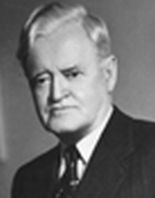Clyde M. Reed: Difference between revisions
m →External links: Remove template using AWB |
Rescuing 1 sources and tagging 0 as dead. #IABot (v1.5beta) |
||
| Line 50: | Line 50: | ||
==External links== |
==External links== |
||
{{Commons category}} <!-- for current and future use if material is uploaded --> |
{{Commons category}} <!-- for current and future use if material is uploaded --> |
||
*[http://www.governor.ks.gov/cedarcrest/tour3.pdf Governor's Mansion Bio] |
*[https://web.archive.org/web/20070928082602/http://www.governor.ks.gov/cedarcrest/tour3.pdf Governor's Mansion Bio] |
||
{{CongBio|R000112}} |
{{CongBio|R000112}} |
||
* {{Find a Grave|6899313}} |
* {{Find a Grave|6899313}} |
||
Revision as of 20:59, 9 August 2017
Clyde M. Reed | |
|---|---|
 | |
| United States Senator from Kansas | |
| In office January 3, 1939 – November 8, 1949 | |
| Preceded by | George McGill |
| Succeeded by | Harry Darby |
| 24th Governor of Kansas | |
| In office January 14, 1929 – January 12, 1931 | |
| Lieutenant | Jacob W. Graybill |
| Preceded by | Benjamin S. Paulen |
| Succeeded by | Harry H. Woodring |
| Personal details | |
| Born | October 19, 1871 Champaign County, Illinois |
| Died | November 8, 1949 (aged 78) Parsons, Kansas |
| Political party | Republican |
| Spouse | Minnie E. Hart |
| Profession | teacher, postman, newspaper editor |
Clyde Martin Reed (October 19, 1871 – November 8, 1949) was an American politician from Kansas who served as both the 24th Governor of Kansas and U.S. Senator from that state.
Biography
Born in Champaign County, Illinois, Reed moved to Kansas with his family when he was four years old. After completing a basic education, he taught school for a single year then began work as a federal employee. He served in different capacities for the next thirty years. He first worked for the railroad mail carrier service, rising to be superintendent of several areas throughout the Midwest and then to the Railway Adjustment Division, Post Office Department superintendent. He married Minnie E. Hart in 1891 and they had ten children.[1]
Career
In 1919, Reed became personal secretary to Governor Henry J. Allen in Topeka, who was also owner and publisher of the "Wichita Beacon". Four years later, he purchased controlling interest in the "Parsons Sun" newspaper of Parsons, Kansas and continued as publisher until his death in 1949.[2] He served on the Kansas Industrial Court from 1920 to 1921, and was a member of the Public Utilities Commission from 1921 to 1924.[3]
Reed was elected Governor of Kansas in 1929, after becoming known as a candidate for being extremely progressive. Shortly after he moved into the governor's mansion, the Great Depression began. Reed called an extra session of the state legislature to combat the troubles faced by Kansans dealing with the depression.
Reed decided not to run for re-election, and returned to newspaper editing. When the anti-Semitic preacher Gerald B. Winrod ran for the Republican nomination for the United States Senate in 1938 and seemed likely to win it, Reed was recruited by the mainstream political establishment as a popular figure who could prevent Winrod's election. Reed won the nomination and the election, and was re-elected in 1944, and served in that office until his death.[4] While in the Senate, his fellow Kansas Senator was also a former governor, Arthur Capper. Reed attempted to obtain the 1942 Republican nomination for governor of Kansas but failed.
Death
Reed died in 1949 while on a visit home from the Senate. The papers from his Senate years are said[who?] to have been destroyed. He in interred at Oakwood Cemetery in Parsons.[5]
See also
References
- ^ "Clyde M. Reed". National Governors Association. Retrieved October 2, 2012.
- ^ "Clyde M. Reed". Parsons Sun.com. Retrieved October 2, 2012.
- ^ "Clyde M. Reed". National Governors Association. Retrieved October 2, 2012.
- ^ "Clyde M. Reed". Biographical directory of the United States Congress. Retrieved October 2, 2012.
- ^ "Clyde M. Reed". Find A Grave. Retrieved October 2, 2012.
External links
- United States Congress. "Clyde M. Reed (id: R000112)". Biographical Directory of the United States Congress.
- Clyde M. Reed at Find a Grave
- Parsons Sun.com
- National Governors Association
- Articles with specifically marked weasel-worded phrases from April 2009
- 1871 births
- 1949 deaths
- People from Champaign County, Illinois
- People from Parsons, Kansas
- American newspaper editors
- Governors of Kansas
- United States Senators from Kansas
- Republican Party United States Senators
- Kansas Republicans
- American Methodists
- Republican Party state governors of the United States
- Journalists from Illinois


